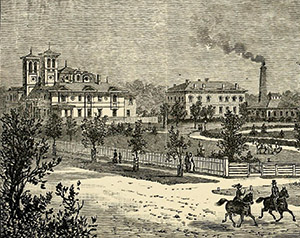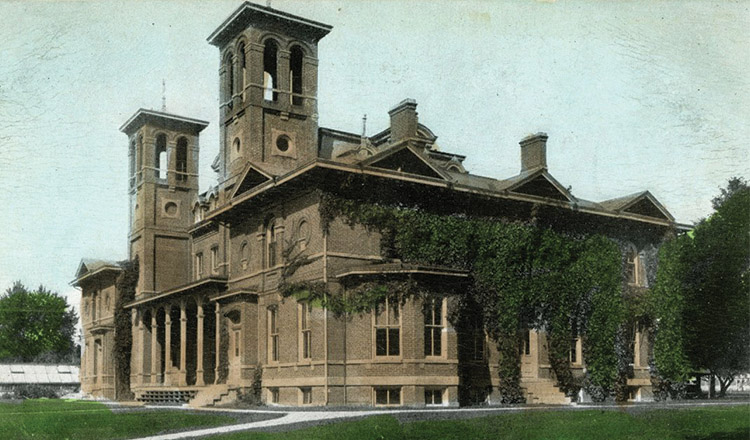Ladies Hall, one of the original three buildings on Purdue’s West Lafayette campus, served several purposes during its existence. Like Purdue’s two other original buildings — Purdue Hall, a dormitory for men, and the Science Building, later known as the Pharmacy Building — Ladies Hall dates to around 1871. It was located near the present-day site of Founders Park between Matthews and Stone Halls.
The hall’s unusual architectural style and ivy-covered walls stood out among the traditional brick buildings on the rest of campus, making it a popular subject of campus imagery. The design was based on a building found on the campus of Amherst College in Massachusetts. Of the University’s three original structures, Ladies Hall was the most costly at around $40,000.
Originally known as Boarding Hall and later Art Hall, Ladies Hall was the first permanent building to be erected north of State Street. For many years, students and unmarried faculty members dined in the building. The first floor was occupied at various times by the art and home economics departments, a school of music, the office of the president, and offices and living quarters for the dean of women.
In 1887, the kitchen of Ladies Hall served as the first classroom for home economics courses; by 1913, the building housed three food laboratories, a clothing laboratory, a food chemistry laboratory, and several recitation rooms.

The upper floors of Ladies Hall served as a women’s dormitory. Rose White, a Purdue Exponent staff member, wrote in 1947, “Some describe it as ‘the pride of campus’ … others say that the Hall was ‘ugly, drafty, poorly-heated, drab, and unattractive,’ and that ‘miserable meals were served in the dining room.’” White summed up her findings, “The attractiveness of Ladies Hall seems, evidently, to depend on place of residence in those days: those living in the Hall found it drab and drafty, those not living in it found it romantic and delightful.”
An extensive $27,000 renovation of Ladies Hall was planned in 1922, but the budget proved to be vastly inadequate, and only minor improvements were made. By 1927, the building was deemed uninhabitable; University officials decided to build a new women’s dormitory, and Ladies Hall was demolished.
What are your favorite hidden gems on campus? Let us know in the comments.

